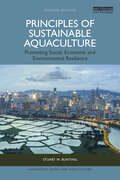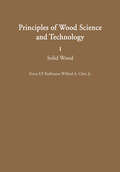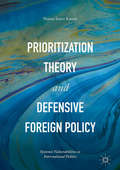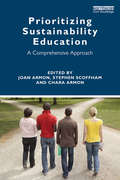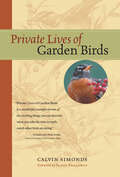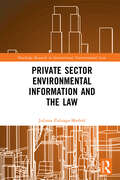- Table View
- List View
Principles of Protein X-Ray Crystallography
by Jan DrenthX-ray crystallography is an established method for studying the structure of proteins and other macromolecules. As the importance of proteins grows, researchers in many fields have found that a working knowledge of X-ray diffraction is an indispensable tool. In this new edition of his essential work, the internationally recognized researcher Dr. Jan Drenth offers an up-to-date and technically rigorous introduction to the subject, providing the theoretical background necessary to understand how the structure of proteins is determined at atomic resolution. New material in the 3rd edition includes a section on twinning, an additional chapter on crystal growth and a discussion of single-wavelength anomalous dispersion.
Principles of Soil Conservation and Management
by Humberto Blanco-Canqui Rattan Lal“Principles of Soil Management and Conservation” comprehensively reviews the state-of-knowledge on soil erosion and management. It discusses in detail soil conservation topics in relation to soil productivity, environment quality, and agronomic production. It addresses the implications of soil erosion with emphasis on global hotspots and synthesizes available from developed and developing countries. It also critically reviews information on no-till management, organic farming, crop residue management for industrial uses, conservation buffers (e.g., grass buffers, agroforestry systems), and the problem of hypoxia in the Gulf of Mexico and in other regions. This book uniquely addresses the global issues including carbon sequestration, net emissions of CO2, and erosion as a sink or source of C under different scenarios of soil management. It also deliberates the implications of the projected global warming on soil erosion and vice versa. The concern about global food security in relation to soil erosion and strategies for confronting the remaining problems in soil management and conservation are specifically addressed. This volume is suitable for both undergraduate and graduate students interested in understanding the principles of soil conservation and management. The book is also useful for practitioners, extension agents, soil conservationists, and policymakers as an important reference material.
Principles of Sustainable Aquaculture: Promoting Social, Economic and Environmental Resilience (Earthscan Food and Agriculture)
by Stuart W. BuntingThis book provides an introduction to sustainable aquaculture practices, focusing on how we develop social, economic and environmental resilience.Aquaculture has seen phenomenal worldwide growth in the past 50 years, and many people view it as the best solution for the provision of high-quality protein to feed the world's growing population. This new edition has been fully revised and updated to reflect new developments in the field and includes new case studies. Focusing on developing more sustainable aquaculture practices and aquatic food systems, the book provides a toolbox of approaches to support widespread adoption and appropriate adaptation of regenerating aquaculture strategies, ensuring that it has practical relevance for both students and professionals. Drawing on a range of case studies from around the world, the book shows where progress, in terms of developing ecologically sound and socially responsible forms of aquaculture, has been made. The book is based on extensive evidence and knowledge of best practices, with guidance on appropriate adaptation and uptake in a variety of environmental, geographic, socio-economic and political settings. Concentrating on low-impact aquaculture systems and approaches, which have minimal adverse effects on the environment, the book also emphasizes socially responsible and equitable aquaculture development to enhance the natural resource base and livelihoods.Principles of Sustainable Aquaculture is essential reading for students and scholars of aquaculture, fisheries, marine and water resource governance, and sustainable agriculture and sustainable food systems more broadly. It will also be of interest to professionals working in the aquaculture and fisheries industries.
Principles of Sustainable Aquaculture: Promoting Social, Economic and Environmental Resilience (Earthscan Food and Agriculture)
by Stuart W. BuntingThis book provides an introduction to sustainable aquaculture practices, focusing on how we develop social, economic and environmental resilience.Aquaculture has seen phenomenal worldwide growth in the past 50 years, and many people view it as the best solution for the provision of high-quality protein to feed the world's growing population. This new edition has been fully revised and updated to reflect new developments in the field and includes new case studies. Focusing on developing more sustainable aquaculture practices and aquatic food systems, the book provides a toolbox of approaches to support widespread adoption and appropriate adaptation of regenerating aquaculture strategies, ensuring that it has practical relevance for both students and professionals. Drawing on a range of case studies from around the world, the book shows where progress, in terms of developing ecologically sound and socially responsible forms of aquaculture, has been made. The book is based on extensive evidence and knowledge of best practices, with guidance on appropriate adaptation and uptake in a variety of environmental, geographic, socio-economic and political settings. Concentrating on low-impact aquaculture systems and approaches, which have minimal adverse effects on the environment, the book also emphasizes socially responsible and equitable aquaculture development to enhance the natural resource base and livelihoods.Principles of Sustainable Aquaculture is essential reading for students and scholars of aquaculture, fisheries, marine and water resource governance, and sustainable agriculture and sustainable food systems more broadly. It will also be of interest to professionals working in the aquaculture and fisheries industries.
Principles of Sustainable Development
by F. Douglas MuschettThis book brings together the collective thinking, ecological perspectives, and experiences of individuals from air quality, land use and transportation disciplines who are working to advance and operationalize sustainable development.
Principles of Sustainable Development
by F. Douglas MuschettThis book brings together the collective thinking, ecological perspectives, and experiences of individuals from air quality, land use and transportation disciplines who are working to advance and operationalize sustainable development.
Principles of Sustainable Soil Management in Agroecosystems
by Rattan Lal B. A. StewartWith the use of high-level soil management technology, Africa could feed several billion people, yet food production has generally stagnated since the 1960s. No matter how powerful the seed technology, the seedling emerging from it can flourish only in a healthy soil. Accordingly, crop yields in Africa, South Asia, and the Caribbean could be double
Principles of Water Law and Administration: National and International, 3rd Edition
by Dante A. Caponera Marcella NanniThis book, which was first published in 1992 and then updated in 2007, provides a tool for dealing with the legal and institutional aspects of water resources management within national contexts and at the level of transboundary water resources. Like its two previous editions, it seeks to cover all aspects that need to be known in order to attain good water governance, but it provides updates concerning developments since 2007. These relate, inter alia, to the following: - the “greening” of water law, which calls for the progressive integration of environmental law principles into domestic and international water law; - the adoption, by the International Law Commission in 2008, of the Draft Articles on the Law of Transboundary Aquifers, and subsequent developments;- the emergence of the right to water as a self-standing human right;- the adoption of domestic water laws supporting integrated water resources management (IWRM) and enhanced public participation in planning and decision making;- the integration into these laws of tools facilitating adaptive water management as a response to climate variability and change;- progress in the implementation of EU law;- recent international agreements and judicial decisions;- efforts of regional organizations other than the EU to steer cooperation in the management of transboundary water resources and the harmonization of national laws;- institutional mechanisms for the management of transboundary water resources (surface and underground). Unique in its scope and nature, the book identifies the legal and institutional issues arising in connection with water resources management and provides guidelines for possible solutions in a manner accessible to a wide range of readers. Thus, it is a useful reference for lawyers and non-lawyers — engineers, hydrologists, hydrogeologists, economists, sociologists — dealing with water resources within government institutions, river basin commissions, international organizations, financing institutions and academic institutions, among other things, and also for students of disciplines related to water resources.
Principles of Water Law and Administration: National and International, 3rd Edition
by Dante A. Caponera Marcella NanniThis book, which was first published in 1992 and then updated in 2007, provides a tool for dealing with the legal and institutional aspects of water resources management within national contexts and at the level of transboundary water resources. Like its two previous editions, it seeks to cover all aspects that need to be known in order to attain good water governance, but it provides updates concerning developments since 2007. These relate, inter alia, to the following: - the “greening” of water law, which calls for the progressive integration of environmental law principles into domestic and international water law; - the adoption, by the International Law Commission in 2008, of the Draft Articles on the Law of Transboundary Aquifers, and subsequent developments;- the emergence of the right to water as a self-standing human right;- the adoption of domestic water laws supporting integrated water resources management (IWRM) and enhanced public participation in planning and decision making;- the integration into these laws of tools facilitating adaptive water management as a response to climate variability and change;- progress in the implementation of EU law;- recent international agreements and judicial decisions;- efforts of regional organizations other than the EU to steer cooperation in the management of transboundary water resources and the harmonization of national laws;- institutional mechanisms for the management of transboundary water resources (surface and underground). Unique in its scope and nature, the book identifies the legal and institutional issues arising in connection with water resources management and provides guidelines for possible solutions in a manner accessible to a wide range of readers. Thus, it is a useful reference for lawyers and non-lawyers — engineers, hydrologists, hydrogeologists, economists, sociologists — dealing with water resources within government institutions, river basin commissions, international organizations, financing institutions and academic institutions, among other things, and also for students of disciplines related to water resources.
Principles of Wood Science and Technology: I Solid Wood
by Franz F.P. Kollmann Wilfred A.Jr. CoteModern forest products research had its start hardly fifty years ago. Today we are in a position to apply the title "wood science" to the field of wood technology that is based on scientific investigation, theoretical as well as experimental. It is this research that fosters new uses for wood as a raw material and that creates the foundation for new industries for the manufacture of wood-base materials such as plywood, laminated products, particle and fiber board and sand wich construction. Wood technology in its broadest sense combines the disciplines of wood anatomy, biology, chemistry, physics and mechanical technology. It is through this interdisciplinary approach that progress has been made in wood seasoning, wood preservation methods, wood machining, surfacing and gluing, and in the many other processes applied in its utilization. In 1936 the senior author published a book entitled, "Technologie des Holzes", which was a first approach to a universal reference book on wood technology. The first edition of Volume I of the Textbook of Wood Technology, co-authored by H. P. BROWN, A. J. P AN SHIN , and C. C. FORSAITH, was published in 1948. An indication of the rapid development of this field can be gained from the fact that the second edition of "Technologie des Holzes und der Holzwerkstoffe", completely revised, was needed by 1951. It contains 2233 pages compared with the 764 pages of the 1936 edition.
Prioritization Theory and Defensive Foreign Policy: Systemic Vulnerabilities in International Politics
by Hanna Samir KassabThis book studies systemic vulnerabilities and their impact on states and individual survival. The author theorizes that the structure of the international system is a product of the distribution of capabilities and vulnerabilities across states. States function or behave in terms of these systemic threats. The author examines a number of specific case-studies focusing on military, economic, environmental, political and cyber vulnerabilities, and how different states are impacted by them. Arguing that current attempts to securitize these vulnerabilities through defensive foreign policies are largely failing, the books makes the case for prioritizing economic development and human security.
Prioritization Theory and Defensive Foreign Policy: Systemic Vulnerabilities in International Politics
by Hanna Samir KassabThis book studies systemic vulnerabilities and their impact on states and individual survival. The author theorizes that the structure of the international system is a product of the distribution of capabilities and vulnerabilities across states. States function or behave in terms of these systemic threats. The author examines a number of specific case-studies focusing on military, economic, environmental, political and cyber vulnerabilities, and how different states are impacted by them. Arguing that current attempts to securitize these vulnerabilities through defensive foreign policies are largely failing, the books makes the case for prioritizing economic development and human security.
Prioritizing Sustainability Education: A Comprehensive Approach
by Joan Armon Stephen Scoffham Chara ArmonPrioritizing Sustainability Education presents theory-to-practice essays and case studies by educators from six countries who elucidate dynamic approaches to sustainability education. Too often, students graduate with exploitative, consumer-driven orientations toward ecosystems and are unprepared to confront the urgent challenges presented by environmental degradation. Educators are prioritizing sustainability-oriented courses and programs that cultivate students’ knowledge, skills, and values and contextualize them within relational connections to local and global ecosystems. Little has yet been written, however, about the comprehensive sustainability education that educators are currently designing and implementing, often across or at the edges of disciplinary boundaries. The approaches described in this book expand beyond conventional emphases on developing students’ attitudes, knowledge, and behaviors by thinking and talking about ecosystems to additionally engaging students with ecosystems in sensory, affective, psychological, and cognitive dimensions, as well as imaginative, spiritual, or existential dimensions that guide environmental care and regeneration. This book supports educators and graduate and upper-level undergraduate students in the humanities, social sciences, environmental studies, environmental sciences, and professional programs in considering how to reorient their fields toward relational sustainability perspectives and practices.
Prioritizing Sustainability Education: A Comprehensive Approach
by Joan Armon Stephen Scoffham Chara ArmonPrioritizing Sustainability Education presents theory-to-practice essays and case studies by educators from six countries who elucidate dynamic approaches to sustainability education. Too often, students graduate with exploitative, consumer-driven orientations toward ecosystems and are unprepared to confront the urgent challenges presented by environmental degradation. Educators are prioritizing sustainability-oriented courses and programs that cultivate students’ knowledge, skills, and values and contextualize them within relational connections to local and global ecosystems. Little has yet been written, however, about the comprehensive sustainability education that educators are currently designing and implementing, often across or at the edges of disciplinary boundaries. The approaches described in this book expand beyond conventional emphases on developing students’ attitudes, knowledge, and behaviors by thinking and talking about ecosystems to additionally engaging students with ecosystems in sensory, affective, psychological, and cognitive dimensions, as well as imaginative, spiritual, or existential dimensions that guide environmental care and regeneration. This book supports educators and graduate and upper-level undergraduate students in the humanities, social sciences, environmental studies, environmental sciences, and professional programs in considering how to reorient their fields toward relational sustainability perspectives and practices.
Prioritizing the Environment in Urban Sustainability Planning: Policies and Practices of Canadian Cities (Sustainable Development Goals Series)
by Natasha Tang Kai Larry SwatukThis book examines the extent to which the environment is addressed in the sustainability plans of Canadian cities. It assesses if and to what extent select leading environmental priorities are addressed in the sustainability plans of sixteen Canadian cities, followed by analysis of efforts towards each priority. It scores and ranks cities against each environmental priority and highlights what makes some cities lead and others lag in environmental sustainability.The book unravels the complexity, similarities, and differences in environmental sustainability planning across major cities in Canada. The project reflects what’s working, who’s leading, and which environmental priorities support the sustainable city model. Climate change has exacerbated the impacts of flood, droughts, wildfire and storms, urban centers must account for sustainability to mitigate and adapt to a changing and uncertain landscape. It begins with robust and integrative sustainability plans that prioritize the environment. This book will make a timely contribution to the on-going debate regarding the ways and means to become a sustainable city. It reflects the on-going sustainable development discourse and deliberations to meet the Sustainable Development Goals. It cut across many SDGs in particular SDG 11, Sustainable Cities and Communities. What makes this study unique is its special attention to environmental priorities within urban sustainability planning. This subject is topical and would appeal to both scholars and practitioners at local, regional, national, and global scales.
The Prison Memoirs of a Japanese Woman
by Kaneko Fumiko Mikiso Hane Jean InglisKaneko Fumiko (1903-1926) wrote this memoir while in prison after being convicted of plotting to assassinate the Japanese emperor. Despite an early life of misery, deprivation, and hardship, she grew up to be a strong and independent young woman. When she moved to Tokyo in 1920, she gravitated to left-wing groups and eventually joined with the Korean nihilist Pak Yeol to form a two-person nihilist organization. Two days after the Great Tokyo Earthquake, in a general wave of anti-leftist and anti-Korean hysteria, the authorities arrested the pair and charged them with high treason. Defiant to the end (she hanged herself in prison on July 23, 1926), Kaneko Fumiko wrote this memoir as an indictment of the society that oppressed her, the family that abused and neglected her, and the imperial system that drove her to her death.
The Prison Memoirs of a Japanese Woman
by Kaneko Fumiko Mikiso Hane Jean InglisKaneko Fumiko (1903-1926) wrote this memoir while in prison after being convicted of plotting to assassinate the Japanese emperor. Despite an early life of misery, deprivation, and hardship, she grew up to be a strong and independent young woman. When she moved to Tokyo in 1920, she gravitated to left-wing groups and eventually joined with the Korean nihilist Pak Yeol to form a two-person nihilist organization. Two days after the Great Tokyo Earthquake, in a general wave of anti-leftist and anti-Korean hysteria, the authorities arrested the pair and charged them with high treason. Defiant to the end (she hanged herself in prison on July 23, 1926), Kaneko Fumiko wrote this memoir as an indictment of the society that oppressed her, the family that abused and neglected her, and the imperial system that drove her to her death.
Private Environmental Regimes in Developing Countries: Globally Sown, Locally Grown
by R. EspachThis book assesses the recent growth and future prospects of private transnational environmental certification and standards regimes, examining in detail to what degree, and under what circumstances, do these transnational regimes truly influence industrial environmental practices in developing countries?
The Private Life of the Hare
by John Lewis-Stempel____________‘To see a hare sit still as stone, to watch a hare boxing on a frosty March morning, to witness a hare bolt . . . these are great things. Every field should have a hare.’ The hare, a night creature and country-dweller, is a rare sight for most people. We know them only from legends and stories. They are shape-shifters, witches’ familiars and symbols of fertility. They are arrogant, as in Aesop’s The Hare and the Tortoise, and absurd, as in Lewis Carroll’s Mad March Hare. In the absence of observed facts, speculation and fantasy have flourished. But real hares? What are they like? In The Private Life of the Hare, John Lewis-Stempel explores myths, history and the reality of the hare. And in vivid, elegant prose he celebrates how, in an age when television cameras have revealed so much in our landscape, the hare remains as elusive and magical as ever.
Private Lives of Garden Birds
by Calvin SimondsBrimming with stories, wisdom, and expert knowledge, this delightful book gives enthusiasts a peek into the private worlds of eleven North American birds: swallows, blue jays, chickadees, song sparrows, house sparrows, phoebes, mockingbirds, crows, red-winged blackbirds, robins, and hummingbirds. Calvin Simonds shows you how to really observe these birds -- how to interpret the caws of crows, recognize blue jays from their facial markings, understand the flight patterns of swallows. You'll be enthralled as you eavesdrop on a group of sparrows trading songs in a "hootenanny," feel the dry grip of a chickadee's claws on your fingers, tramp through a summer meadow to visit a phoebe, and much more.
Private Property Rights and the Environment: Our Responsibilities to Global Natural Resources (Palgrave Studies in Environmental Policy and Regulation)
by Shelly Hiller MargueratThis book explores the current notion and definition of property, and its interpretation and implementation in relation to the environment. The author examines two primary problems: the degradation of land, natural resources and animal abuse; and the increasing erosion of private property rights from property owners by the arbitrary interference of state governments. Examining texts from antiquity to contemporary legislation, it portrays the historical development of the understanding of “nature” as “property” and discusses our obligations towards the environment. Drawing on the most influential political-philosophical texts from all periods of property rights history, the author analyzes modern national and international legislation and case law to offer legally-grounded evidence and explanations. This book advocates the incorporation of a formula that guarantees the protection of property rights into the legal system, and imposes clear and effective responsibility on property owners to limit the use of natural resources and the abuse of animals. This book will appeal to practitioners, researchers and students with an interest in environmental and private property law.
Private Sector Environmental Information and the Law (Routledge Research in International Environmental Law)
by Juliana Zuluaga MadridCurrent advancements in civil rights and environmental activism emphasize the crucial importance of making environmental information widely available to the public, regardless of whether it is in the hands of the government or of corporations, especially when the information is needed to understand and prevent risks for human health and the environment. In the wake of a resurgence of environmental and civil rights activism, conflicts flare between the right of the people to know and the right of private actors to keep certain information hidden, mostly for commercial reasons. This book offers a detailed comparative analysis of how environmental information is being accessed in different countries and jurisdictions, and how these issues are currently being handled by judges and governments. Focusing on the right of access to environmental information held and produced by private actors and the legal issues that emerge when other values and rights are compromised, this book offers an alternative framework to improve on current legal systems, suggesting a more nuanced and balanced approach that takes both set of interests duly into consideration. Providing an integrated approach to public environmental law and private commercial law, the book integrates the arguments from both sides to establish a common ground, defining shared principles and models that provide a solid basis for a robust new system. Reviewing access to private sector information at a truly international level, this book will be relevant to students, academics and practitioners working in these areas.
Private Sector Environmental Information and the Law (Routledge Research in International Environmental Law)
by Juliana Zuluaga MadridCurrent advancements in civil rights and environmental activism emphasize the crucial importance of making environmental information widely available to the public, regardless of whether it is in the hands of the government or of corporations, especially when the information is needed to understand and prevent risks for human health and the environment. In the wake of a resurgence of environmental and civil rights activism, conflicts flare between the right of the people to know and the right of private actors to keep certain information hidden, mostly for commercial reasons. This book offers a detailed comparative analysis of how environmental information is being accessed in different countries and jurisdictions, and how these issues are currently being handled by judges and governments. Focusing on the right of access to environmental information held and produced by private actors and the legal issues that emerge when other values and rights are compromised, this book offers an alternative framework to improve on current legal systems, suggesting a more nuanced and balanced approach that takes both set of interests duly into consideration. Providing an integrated approach to public environmental law and private commercial law, the book integrates the arguments from both sides to establish a common ground, defining shared principles and models that provide a solid basis for a robust new system. Reviewing access to private sector information at a truly international level, this book will be relevant to students, academics and practitioners working in these areas.
Private Sector Housing and Health: Evaluating the Effectiveness of Regulation Intended to Protect the Health of Tenants (Routledge Focus on Environmental Health)
by Paul OattThis book is an evaluation of the effectiveness of housing enforcement and tenant protection in England’s private rented sector using policy analysis to evaluate regulatory provisions and local authority guidance to identify the advantages and limitations of existing policies. From the environmental health practitioner perspective, the targeted health problem is occupiers privately renting from negligent or criminal landlords who are subsequently exposed to hazardous conditions arising from disrepair.Paul Oatt’s analysis looks at the powers local authorities have to address retaliatory eviction when enforcing against housing disrepair and digs deeper into their duties to prevent homelessness and powers to protect tenants from illegal eviction. He then explores the potential for tenants to take private action against landlords over failures to address disrepair, before finally discussing proposals put forward by the government to abolish retaliatory evictions and improve security of tenure with changes to contractual arrangements between landlords and tenants, based on successive stakeholder consultations. The policy analysis looks at these aspects to define the overall effectiveness of housing strategies and their implementation, examining causality, plausibility and intervention logic as well as the unintended effects on the population. Equitability is examined to see where policy effects create inequalities as well as the costs, feasibility and acceptability of policies from landlords' and tenants’ perspectives. The book will be of relevance to professionals interested in housing and health, as well as students at universities that teach courses in environmental health, public health, and housing studies.
Private Sector Housing and Health: Evaluating the Effectiveness of Regulation Intended to Protect the Health of Tenants (Routledge Focus on Environmental Health)
by Paul OattThis book is an evaluation of the effectiveness of housing enforcement and tenant protection in England’s private rented sector using policy analysis to evaluate regulatory provisions and local authority guidance to identify the advantages and limitations of existing policies. From the environmental health practitioner perspective, the targeted health problem is occupiers privately renting from negligent or criminal landlords who are subsequently exposed to hazardous conditions arising from disrepair.Paul Oatt’s analysis looks at the powers local authorities have to address retaliatory eviction when enforcing against housing disrepair and digs deeper into their duties to prevent homelessness and powers to protect tenants from illegal eviction. He then explores the potential for tenants to take private action against landlords over failures to address disrepair, before finally discussing proposals put forward by the government to abolish retaliatory evictions and improve security of tenure with changes to contractual arrangements between landlords and tenants, based on successive stakeholder consultations. The policy analysis looks at these aspects to define the overall effectiveness of housing strategies and their implementation, examining causality, plausibility and intervention logic as well as the unintended effects on the population. Equitability is examined to see where policy effects create inequalities as well as the costs, feasibility and acceptability of policies from landlords' and tenants’ perspectives. The book will be of relevance to professionals interested in housing and health, as well as students at universities that teach courses in environmental health, public health, and housing studies.


